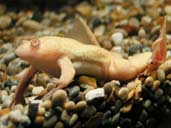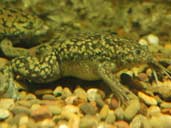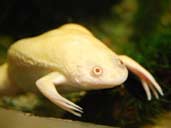 Photo By Paul Robinson |
 |
 Photo By Kuribo |
African Clawed Frog Care Sheet
Common name: African Clawed Frog
Scientific name: Xenopus laevis
The genus Xenopus belongs to the Pipidae family and actually derived its name from the Latin meaning ‘strange foot’.
Description
Description: African Clawed Frogs can change their colouring to camouflage themselves in different surroundings, but generally they have blothchy olive-brown to grayish black skin with paler beige undersides. They have strong hind limbs and arms that end in clawed, but very sensitive hands. They have a flattened appearance, which makes them look quite distinguishable, especially since they also have no eye lids, no tongue and no teeth.
Size: African Clawed Frogs can grow up to 10-15cm (4-5 inches).
Life span: African Clawed Frogs can live up to 20 years with appropriate care, but average at about 10-15 years generally.
Origin: Southern Africa predominantly, but can be found in other parts of Africa. They have also been introduced to other parts of the world, such as North America, where they are now considered a pest due to their appetite for native creatures and the subsequent decline in native populations.
Habitat: African Clawed Frogs live in shallow ponds, lakes and ditches in quiet, warm water. They are fully aquatic, so spend the majority of their time burrowing in thick mud. They like stagnant water with plenty of organic vegetation clouding up the water. They may also burrow under the mud for many months when their water sources dry up in the sunny season.
Interesting Facts about the African Clawed Frog
In the past African Clawed Frogs were used for Pregnancy testing. It was found that when female African Clawed Frogs were injected with female urine, they would produce eggs within 48 hours if that woman was pregnant. This is due to their ability to detect HCG, which is a hormone that woman only produce during pregnancy.
The African Clawed Frog is famous for being the first vertebrate ever to be cloned and they still play a very important part in genetic research today.
African Clawed Frogs have been into space! They were taken aboard a shuttle in 1992 for a experiment into the effects of zero-gravity on breeding cycles and development.
Things to consider before purchasing your first Amphibian
• Who will look after your new pet if you are away?
• Can you obtain its food easily from your local pet shop?
• Would you be comfortable feeding live insects as food?
• Are you comfortable having live food in the house to feed your pet?
• Is the rest of the family happy to live with an amphibian?
Captive Care
Temperament: African Clawed Frogs are great first amphibians for beginners, because they are relatively easy to care for. They are also a very hardy species, so it is unlikely that your pet will become ill. They are social and intelligent amphibians, so make entertaining pets.
The only thing to worry about with African Clawed Frogs is their predatory tendencies. They will generally eat anything that moves, so choose tank mates wisely. Usually if you only house your frog with other African Clawed Frogs of a similar size you stand a better chance of avoiding any problems.
Housing: An Aquarium will be needed to house your African Clawed Frog as they are entirely aquatic.
They are quite an active species so the bigger the aquarium you can provide the better. The aquarium should be fitted with a tight fitting lid, as they are prone to try and escape from their enclosures. African Clawed Frogs are not adapted to life on land, so will dehydrate and die quickly if they escape and are not placed back in the water in time.
Ensure that there is no metal within the aquarium, as metal is toxic to African Clawed Frogs.
The bottom of the tank may be lined with a aquarium gravel substrate, but larger gravel is more appropriate than smaller grains to avoid your African Clawed Frog from accidently ingesting some of the gravel.
Your aquarium should contain:
Water
The entire aquarium should be dedicated to providing adequate water for your African Clawed Frog. The water should be at a depth of approximately 18-30CM (7 -12 inch) or as deep as your frogs height. A general rule is that your African Clawed Frog should be able to stand on the bottom of the tank and still keep it’s head above the water.
Change the water daily to avoid the build up of bacteria, unless a gentle filter can be provided to keep the water clean. With a filter it should only be necessary to change one third of the water every week, but ensure that if you do use a filter, that it is gentle enough not to cause your African Clawed Frogs any stress. African Clawed Frogs are very sensitive to vibrations and movement in the water, so constant sensations from a powerful filter will cause stress to your African Clawed Frogs.
De-chlorinated or bottled spring water should always be used as African Clawed Frogs are really sensitive to various chemicals and cannot handle water with Chlorine and Chloramine in.
A place for your African Clawed Frog to hide
All amphibians require somewhere to hide and may become stressed if this is not provided. This could be a plant pot on its side submerged in the water, these are low cost and easily cleaned if they become soiled.
Live plants can be used in your aquarium, but African Clawed Frogs are known to burrow, so expect them to be easily uprooted. Fake plants may be secured in place using aquarium silicon, but please be aware that this may make cleaning out the aquarium décor much more difficult.
African Clawed Frogs have very powerful rear legs, so can be quite destructive to aquarium décor.
A change of scenery
African Clawed Frog are very inquisitive animals and like to explore new surroundings. Once in a while change the layout of the aquarium. This will keep your African Clawed Frog from becoming bored. You will notice once you put your African Clawed Frog back in the tank it will start to re-explore its new surroundings.
Heat
The ideal water temperature for your African Clawed Frog is a temperature gradient of 20-25°C (68-77°F). To maintain these temperatures you can use an aquarium water heater, regulated by an appropriate thermostat (most aquarium heaters have combined thermostats).
It's useful to have a small thermometer on either end of the aquarium to check the water temperature.
Feeding
African Clawed Frogs are interesting amphibians to watch at mealtimes, as they have no teeth or tongue, so use their hands to push food into their mouths. They should be fed 3-4 times a week with a varied diet of appropriately sized prey items, such as earthworms, wax worms, small feeder fish and turtle pellets. Feed 3 or 4 prey items per African Clawed Frog per feeding or just as much as they will eat within 10 minutes.
In the wild they would also eat small crustaceans, tadpoles and any other organic waste. They are natural scavengers and will usually eat any living, dead or dying prey items.
Lighting
African Clawed Frogs should be kept out of direct sunlight, but with a 12/12 light cycle (12 hours light to 12 hours dark). Natural sunlight should suffice. African Clawed Frogs do not need additional UV, but if you would like to add additional light then a fluorescent tube is ideal as it won’t give out any heat.
Cleaning
Your African Clawed Frog’s aquarium should be inspected daily. Every one to two weeks (or more frequently if a filter is not used) clean out the tank completely and sterilise using a reptile/amphibian friendly disinfectant. Sterilise any décor to replace when the tank has been cleaned. The water needs to be emptied, cleaned and refreshed with fresh de-chlorinated water.
Your African Clawed Frog should be moved to a temporary tank whilst being cleaned and care must be taken to make sure no chemicals are used in the cleaning process, as these can harm your Frogs.
Handling
African Clawed Frogs are extremely hard to handle, because they have a slimy coating to their skins, which makes them really slippery. For this reason handling should be avoided. If it is necessary to handle your frogs make sure you do so with clean, wet hands and take care to prevent your frog from slipping from your grip.
An aquarium net should not be used to move your African Clawed Frogs, as their delicate clawed hands and webbed feet can be damaged if they become entangled in the netting.
Sexing
The easiest way to determine the sex of your African Clawed Frog is by listening. Males will call during the mating season, making a clicking sound, due to their lack of vocal chords.
Additionally, females are usually larger than males and tend to have a more rounded body shape.
Breeding
African Clawed Frogs require a simulated spring rainy season to begin the breeding process. This can be achieved by adding 5-8 CM (2-3 inch) of cool water to the aquarium or simply spraying the surface of the water regularly with de-chlorinated water from a spray bottle.
During amplexus (when the male frog grips hold of the female from behind to encourage her to lay her eggs), up to a 1,000 eggs can be spawned.
Eggs should be removed as soon as possible to prevent the adults from eating them. They can be kept in a container containing shallow de-chlorinated water and will hatch within a few days.
The tadpoles of the species are cannibalistic, so thinning out into separate containers, if possible, is advised. Feed them on micro-organisms from ponds or fish fry food. Strained egg yolk may also be given to them.
Metamorphosis occurs in approximately 6 weeks and African Clawed Frogs reach maturity at about 10-12 months.
Other questions about the African Clawed Frog
If you have any other questions why not join The Amphibian Forum and ask one of the many experienced keepers, the reason this website was set up was so people in the amphibian keeping hobby could share their experiences with others.

